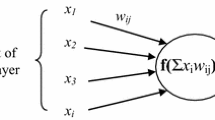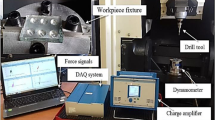Abstract
In spite of advanced material cutting technology, there are still some problems due to unpredicted vibrations on horizontal and vertical directions on column drilling machines. This paper presents an investigation for drilling condition of drill column machines performance using proposed neural networks. The investigation is divided into two parts. First, the drill column machine is employed to analyze vibrations with steel and aluminum materials for increased drilling speeds. During the working of the system, some measuring points are indicated to analyses of drilling conditions. Finally, two types of proposed neural networks predictors are used to predict vibration variation for both cases of steel and aluminum materials of drilling systems. The experimental and simulation result is improved that radial basis neural network has superior performance to adapt experimental applications for drill column machines.















Similar content being viewed by others
Abbreviations
- \(A_{sz}\) :
-
Cutting face (mm2)
- a m :
-
Measured acceleration value (m/s2)
- a n :
-
Neural networks acceleration value (m/s2)
- BPNN:
-
Back propagation neural network
- b :
-
Chip width per a tooth (mm)
- \(c_{f}\) :
-
Stiffness of the work piece (N/m)
- d :
-
Tool diameter (mm)
- E 1 :
-
Error between experimental and neural network output signals
- E 2 :
-
Propagation error between hidden and input layers
- F rz :
-
Radial force (N)
- F sz :
-
Cutting force (N)
- F vz :
-
Feed force (N)
- \(f_{z}\) :
-
Feed per tooth (mm/rev)
- h :
-
Chip thickness per a tooth (mm)
- \(k_{r}\) :
-
All other influences
- k s :
-
Specific feed force (N/mm2)
- k s 1:1 :
-
Basic specific feed force (N/mm2)
- \(k_{\text{w}}\) :
-
Influence of tool wear
- \(l_{b}\) :
-
Height of chip (mm)
- \(m\) :
-
Influence of material type
- n :
-
Velocity of drill (rpm)
- N :
-
Iteration numbers
- n I :
-
Number of neurons in input layer
- n H :
-
Number of neurons in hidden layer
- n O :
-
Number of neurons in output layer
- RBNN:
-
Radial basis neural network
- \(s_{z}\) :
-
Feed per a tooth (mm/rev)
- t :
-
Time (s)
- u :
-
Feed velocity (mm/min)
- \(v\) :
-
Cutting speed (m/min)
- \(W_{ij}\) :
-
Weights between input and the hidden layers
- \(W_{ji}\) :
-
Weights between hidden and the output layers
- \(\alpha\) :
-
Momentum term
- α fv :
-
Function of the feed velocity
- \(\eta\) :
-
Learning rate
- \(\theta\) :
-
Tool angle (°)
- Ø :
-
Drill angle (°)
References
Schmitz T, Davies M, Kennedy M (2001) Tool point frequency response prediction for high speed machining by RCSA. J Manuf Sci Eng 123(4):700–707
Zhang J, Schmitz T, Zhoa W, Lu B (2011) Receptance coupling for tool point dynamics prediction on machine tools. Chin J Mech Eng 24:1–6
Erturk A, Özgüven HN, Budak E (2006) Analytical modeling of spindle–tool dynamics on machine tools using Timoshenko beam model and receptance coupling for the prediction of tool point FRF. Int J Mach Tools Manuf 46:1901–1912
Pedrammehr S, Farrokhi H, Khani S, Rajab A, Pakzad S, Mahboubkhah M, Ettefagh MM, Sadeghi MH (2012) Modal analysis of the milling machine structure through FEM and experimental test. Adv Mater Res 383–390:6717–6721
Wu Z, Xu C, Zhang J, Yu D, Feng P (2010) Modal and harmonic response analysis and evaluation of machine tools. In: International conference on digital manufacturing and automation, pp 928–935
Alan S, Budak E, Özgüven HN (2010) Analytical prediction of part dynamics for machining stability analysis. Int J Autom Technol 4(3):259–267
Arvajeh T, Ismail F (2006) Machining stability in high-speed drilling—part 1 modeling vibration stability in bending. Int J Mach Tools Manuf 46:1563–1572
Pirtini M, Lazoglu I (2005) Forces and hole quality in drilling. Int J Mach Tools Manuf 45:1271–1281
Ozşahin O, Budak E, Özgüven HN (2014) In-process tool point FRF identification under operational conditions using inverse stability solution. Int J Mach Tools Manuf 89:64–73
Eski İ (2012) Vibration analysis of drilling machine using proposed artificial neural network predictors. J Mech Sci Technol 26(10):3037–3046
Akkurt M (1993) Talaş Kaldırma ve Takım Tezgahları Problemleri. Birsen, Istanbul
Iserman R (2006) Fault diagnosis applications. Springer, Berlin
Yıldırım Ş, Erkaya S, Eski I, Uzmay I (2009) Noise and vibration analysis of car engines using proposed neural network. J Vib Control 15:133–156
Eski İ, Erkaya S, Savaş S, Yildirim Ş (2011) Fault detection on robot manipulators using artificial neural networks. Robot Comput Integr Manuf 27:115–123
Csokmai LS, Ţarcă RC, Bungău C, Husi G (2015) A comprehensive approach to off-line advanced error troubleshooting in intelligent manufacturing systems. Int J Comput Commun Control 10(1):30–37
Author information
Authors and Affiliations
Corresponding author
Rights and permissions
About this article
Cite this article
Esim, E., Yıldırım, Ş. Drilling performance analysis of drill column machine using proposed neural networks. Neural Comput & Applic 28 (Suppl 1), 79–90 (2017). https://doi.org/10.1007/s00521-016-2322-8
Received:
Accepted:
Published:
Issue Date:
DOI: https://doi.org/10.1007/s00521-016-2322-8




